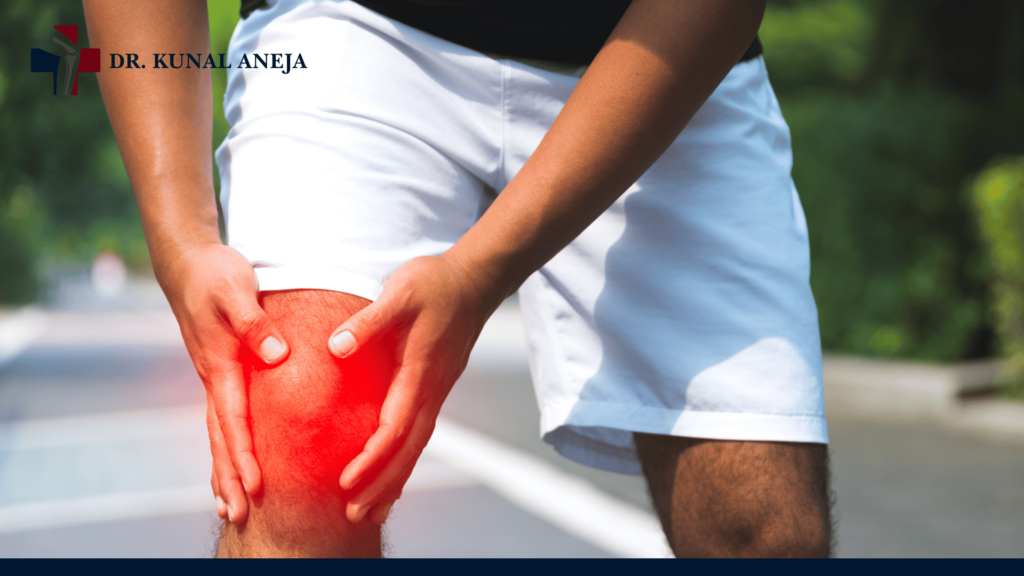Overview
Robotic knee replacement surgery in India has revolutionized the way joint pain is treated, offering unmatched precision, faster recovery, and long-term mobility. Among the few pioneers advancing this innovation in India, Dr. Kunal Aneja stands out as a trusted name. Known for his patient-centric care and expertise in advanced orthopaedic technologies, Dr. Aneja offers world-class robotic knee replacement solutions that restore mobility and improve quality of life.
In this comprehensive guide, learn about the advantages of robotic-assisted knee replacement, the procedure, recovery, and why Dr. Kunal Aneja is one of the top choices for robotic knee replacement surgery in India.

What is Robotic Knee Replacement Surgery?
Robotic knee replacement is a next-generation advancement in orthopaedic surgery where computer-guided robotics assist the surgeon in achieving perfect alignment and implant placement. Unlike traditional methods, this technique allows for:
- Sub-millimeter precision
- Customized surgical plans using patient-specific data
- Minimally invasive incisions
- Lower risk of complications and faster recovery
Benefits of Robotic Knee Replacement Surgery in India
India has emerged as a global hub for advanced orthopaedic care, offering world-class technology at a fraction of the cost compared to Western countries. Patients from India and abroad are increasingly choosing robotic knee replacement surgery in India for its:
- High success rate
- Faster discharge times (2–3 days post-surgery)
- Fewer post-operative complications
- Customized treatment approach
Robotic-assisted surgeries ensure higher implant longevity and better alignment, significantly reducing the need for revision surgeries.
Why Choose Dr. Kunal Aneja for Robotic Knee Replacement in India?
Dr. Kunal Aneja is a leading orthopaedic specialist known for offering advanced knee replacement procedures, including robotic and navigation-assisted surgeries. He has been at the forefront of introducing precision-based orthopaedic treatments in India, ensuring optimal results and enhanced recovery for his patients.
Key Highlights:
- Expertise in robotic and minimally invasive joint surgeries
- Known for a patient-first approach and comprehensive pre- and post-operative care
- Utilizes advanced robotics systems for enhanced surgical accuracy
- High patient satisfaction with excellent mobility outcomes
Dr. Aneja’s focus is not just on replacing the joint but restoring full function, so patients return to active lifestyles—walking, climbing stairs, and even resuming sports in some cases.
How the Procedure Works
1. Pre-Surgical Planning
Before the surgery, a detailed 3D CT scan is taken of the patient’s knee to develop a personalized surgical plan. The robotic software assists in mapping the exact placement and alignment of the implant.
2. During Surgery
The robotic arm works as an extension of the surgeon’s hand, ensuring precise bone cuts and implant positioning. The surgeon remains in full control, while the robot enhances safety and accuracy.
3. Post-Surgery
Robotic surgery often allows for:
- Minimal blood loss
- Smaller incisions
- Less pain
- Faster discharge
- Quicker rehabilitation
Most patients begin walking with assistance within 24–48 hours post-operation.
What Makes Robotic Knee Replacement Better Than Traditional Surgery?
| Feature | Traditional Surgery | Robotic-Assisted Surgery |
|---|---|---|
| Implant Alignment | Manual, prone to human error | Sub-millimeter robotic accuracy |
| Incision Size | Larger | Minimal |
| Blood Loss | Moderate | Significantly reduced |
| Recovery Time | 6–12 weeks | 4–6 weeks |
| Pain Management | More medication | Less medication needed |
| Revision Surgery Risk | Moderate | Much lower |
Ideal Candidates for Robotic Knee Replacement Surgery
You may be a suitable candidate if you:
- Suffer from advanced knee arthritis
- Experience chronic joint pain and stiffness
- Have tried conservative treatments with no relief
- Want a faster recovery and long-lasting solution
- Are looking for a minimally invasive surgical option
Dr. Kunal Aneja ensures every patient undergoes a thorough evaluation to determine if robotic surgery is the right choice.
International Patient Care
India is a global leader in medical tourism for joint replacement surgeries. Dr. Kunal Aneja’s practice is fully equipped to handle international patients with:
- Virtual consultations
- Assistance with medical visas
- Language support
- Coordinated travel and lodging services
- Post-op rehabilitation guidance
Patients from the USA, UK, UAE, Australia, and other parts of Asia routinely seek treatment under his expert care.
Recovery Timeline
- Day 1–2: Begin assisted walking
- Week 1–2: Physical therapy begins
- Week 3–4: Return to light activities
- Week 6–8: Resume daily routine with minimal restrictions
With robotic surgery, many patients return to near-normal routines in just 4–6 weeks—significantly faster than conventional knee replacement recovery.

Conclusion
When it comes to robotic knee replacement surgery in India, choosing a surgeon with the right blend of expertise, advanced technology, and patient empathy is crucial. Dr. Kunal Aneja combines all these elements, delivering results that go beyond expectations.
FAQs
1. Is robotic knee replacement safe in India?
Ans. Yes, robotic knee replacement in India is performed with the latest technology, ensuring high safety standards, accuracy, and faster recovery.
2. What is the recovery time after robotic knee replacement?
Ans. Most patients recover within 4–6 weeks with minimal pain and can resume daily activities faster than traditional surgery.
3. How long does a robotic knee implant last?
Ans. With precise placement, implants can last 15–20 years or more depending on lifestyle and post-op care.
4. Is robotic knee surgery more expensive?
Ans. While the initial cost may be slightly higher, it offers better long-term value due to reduced complications and revision rates.
5. Can both knees be replaced robotically?
Ans. Yes, depending on the patient’s condition, simultaneous or staged bilateral robotic knee replacements can be performed safely.

